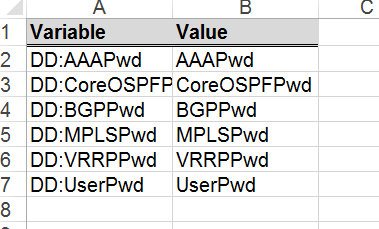Spreadsheet tabs
Quick reference : Spreadsheet tabs
This project must have at least one Device, Data and Template worksheets, Globals tabs are optional. Other worksheets are ignored by Gen.IT. The enterprise license allows the use of more then one Excel file within a project, with each containing Device, Data, Template, and or Globals worksheets.

•Device-<Description>
•Data-<Description>
•Template-<Description>
•Globals-<Description>
Enterprise users may use sheets within up to 10 Excel spreadsheet files. The worksheets from all files will be aggregated into data tables within Gen.IT.
<Description> are optional user configurable labels that have no significance to the Gen.IT application.
Device tabs are used to define devices and associated templates.
Device and Data tabs are dependent on each other and are linked via the ID values on each tab. All Device and Data tabs must contain the same amount of and equal ID values. No duplicate ID’s may exist on a single tab. Typically, the row or column number is used as the ID, with the ID cell formatted as ‘ID:[0-9]’. The Excel formulas ="ID:"&TEXT(ROW(),"000") or ="ID:"&TEXT(COLUMN(),"000") may be used to populate the ID columns or rows.
Device and Data tabs can be defined in one of two ways – ID per Row, or ID per Column – and must be defined the same way within any given project.
Device Sheets

A list of data fields used to define devices is below.
Required:
•DN:<DeviceID>:<Description> – Defines a device name. Only 1 DN per device is allowed, e.g. DN:A:Primary Router.
•DT:<DeviceID>:<Description> – Defines the template associated with DN:<x> . Multiple DT’s per device are allowed, e.g. DT:A:SecurityTemplates.
Optional:
•DR:<DeviceID>:<Description> – Specifies the produced output, does not include any additional Gen IT information (Templates names, start/stop info), e.g. DR:A:Description
•DF:<DeviceID>:<Description> – Defines a device filename when saving. Only 1 DF per device is allowed, e.g. DF:A:Primary Router Filename.
•DA:<DeviceID>:<Description> – Specifies the produced output may be appended to any existing found file when saving. e.g. DA:A:Append
•DL:<DeviceID>:<Description> – Specifies the produced output may be saved using LFs instead of CRLFs. e.g. DL:A:LineFeed
•DE:<DeviceID>:<Description> – Specifies the encoding scheme to be used when saving in text format. e.g. DE:A:Encoding
•DS:<DeviceID>:<Description> – Specifies the file type to be used when saving. e.g. DS:A:FileType
•DO:<DeviceID>:<Description> – Specifies the order in which to process Include Statements or Copound Templates. e.g. DO:A:ProcessOrder
Multiple DT’s (templates) may be defined for each DN.
A single DA, DF, DR, DL, DE, DS and DO may optionally be defined for each DN.
The image at the top of this page shows the following:
•5 individual sites with ID's 4 to 8
•Each site has 2 devices defined - DN ID's 1 and 2
•Device ID 1 has 2 templates associated - HubBase and HubVPN
•Device ID 2 has 2 templates associated - RemoteSiteBase and RemoteSiteVPN
Valid data options wich may be configured per device are:
•DR: 0 (Default) or 1
•DA: 0 (Default) or 1
•DL: 0 (Default) or 1
•DE: ASCII (Default), UTF7, UTF8, UTF8BoM, UTF16, UTF32
•DS: TXT (Default), RTF, XLS
•DO: I for Include Statement, or C for Compound Template. e.g. IICCCCI
Further information regarding Device worksheets may be found here.
Data Sheets

Data tabs are used to define data variables and associated replacement values.
Note: The words row and column are used interchangeably below as the exact use depends on the where ID per row or ID per column is used.
The first row/column in each data sheet must be used as a heading row/column for all rows/columns. Variable names must be prefixed by 'DD:'.
All other rows/columns are ignored by Gen.IT. Other non ‘DD:’ and ‘ID’ rows /columns may contain any data, text or formulas.
The first row/column in each of the data sheets must be labeled as 'ID' and contain numerically unique values for each row/column. This ID column is used to link the various rows /columns spread across multiple sheets, and must be identical across all Data and Device sheets.
Multiple sheets containing the same columns/data/headings should be avaioded.
Some columns are required as defined in the spreadsheet specific settings file. These are used by GenIT to display lists or sorted content. These are:
•DD:<Category> - A data column used as the primary sort field within the Gen.IT application. e.g. DD:SiteClassification
•DD:<PriListTag> - A data column used as the secondary sort field within the Gen.IT application. e.g. DD:SiteName
•DD:<Description> - Up to 4 data column used as the description field within the Gen.IT application. e.g. DD:SiteDescription
Note: DD:<VariableName> – Can also be writen as Variable:<VariableName>
All cell values may be populated using any standard Excel method. i.e. text, functions, lookup tables, formulas, vba and macro's etc.
Further information regarding Data worksheets may be found here.
Template Sheets
![]()
Template tabs are used to specify templates containing text and variables.
The first row in each Template sheet must be used as a heading row (i.e. template name) for a column.
•T:<TemplateName>
Or
•Template:<TemplateName>
Any text placed under the template heading will be considered as to be part of the template.
Further information regarding Template worksheets may be found here.
Globals Sheets

Any variables that apply globally, to all ID's may be defined here. If a device data (DD) variable is also defined, then the DD variable takes preference of the global variable.
Further information regarding Globals worksheets may be found here.